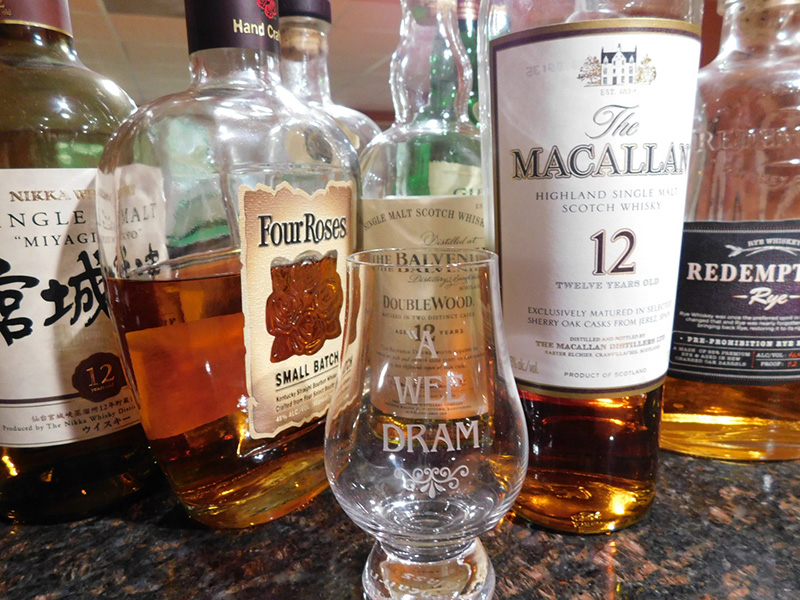Is it Whisky or Whiskey and what is the difference?
The word Whisky has its origins in the Scottish Gaelic translation of the Latin term for distilled alcohol – Aqua Vitae or “The Water of Life”. The translated term “uisge beatha” was simplified over time and the spelling was adjusted as it was assimilated into English to become what we now know as whisky. So why the different spellings, you ask? Well, the simple answer is geography. In general, Irish and American versions of this magnificent beverage use Whiskey, while Scotch and other variants around the world stick with the classic Whisky. This is not a hard and fast rule as you will find some American distilleries like George Dickel, Maker’s Mark, and Old Forester producing their elixirs without that pesky “e” but for the most part the geographic distinction holds.
So if they are all considered Whisk(e)y, what is the difference between Scotch, Irish, Bourbon, and Rye? Well, the first thing you need to know is that to be considered Whisk(e)y at all it has to be a distilled alcohol made from a fermented grain mash. It must be distilled at a minimum of 40% and a maximum of 94.8% alcohol by volume. The main difference between types of whiskeys depends mostly on the type of grain used for the mash. The finished product is typically aged in wooden casks, which depending on the type of wood and length of time, gives each variety its distinct color and flavor.
Here are the basic differences between different types of your favorite spirit:
- Scotch
Scotch is typically made from malted barley (malt whisky) but it can also be made from different types of grains (grain whisky). These variants can also be brought together for a blended whisky. Anything bearing the label “Scotch” is required to be distilled in Scotland and matured for a minimum of three years in oak casks. Scotch is often aged in barrels that previously held bourbon so the essence of the bourbon as well as the wood merge with the scotch as it ages to produce a unique flavor. Scotch malt whiskies are divided into five main regions: Highland, Lowland, Islay, Speyside and Campbeltown. Different regions use different methods of malting and distillation that produce unique flavors. Some will use peat in their malting process to give the whisky a more smokey flavor while island malts and those from Islay sometimes employ seaweed which produces something a little more antiseptic. Aficionados generally prefer sticking with a specific region. Fortunately, each region hosts dozens of different distilleries so even the snobbiest among us can enjoy a little variety when they imbibe. - Irish
Irish Whiskey is considered a grain whiskey and is traditionally distilled using pot stills from a mash of malted cereals (with or without whole grains of other cereals). By law, Irish whiskey must be produced in Ireland and aged in wooden casks for a period of no less than three years although it is generally longer by far. Currently there are only 18 whiskey distilleries in operation in Ireland but not all of them have been around long enough to sell any of the Whiskey they have produced. Irish Whiskey generally does not use peat in its malting process resulting in a whiskey with a smoother finish than some of their neighbors. - Bourbon
Bourbon comprises two-thirds of the $1.6 billion spirits export market from the united States. To be called Bourbon, a whiskey needs to be produced in the United States, be made from a grain mixture that is at least 51% corn and aged in new, charred oak barrels. I can’t be distilled to be more than 160 proof (80% alcohol by volume) and it cannot enter a barrel at more than 125 proof (62.5% alcohol by volume). Like other whiskeys it is bottled at 80 proof or more (40% alcohol by volume). There is no specific aging requirement for bourbon so you can find things aged for as little as three months but anything aged less than four years requires an age statement to be added to the label. Because it is distilled from corn, Bourbon is a much sweeter whiskey than any of the others listed but like with the others, much of the flavor character in Bourbon comes from the caramelized sugars and vanillins in the charred wood. - Rye
Rye whiskey is very similar to Bourbon in the way it is produced but closer in flavor to Irish whiskey. To be called Rye in the U.S., a whiskey must be made from a mash of at least 51 percent rye and aged in new, charred oak barrels. The mash generally also includes corn and malted barley but the only requirement is the rye. Like Bourbon it has to be distilled to no more than 160 proof (80% alcohol by volume), and and it cannot enter a barrel at more than 125 proof (62.5% alcohol by volume). These requirements only apply to U.S. distillers as there are a number of Canadian whiskies that call themselves Rye but do not necessarily contain any rye at all.
Ingredients and production methods are the primary difference between each of the whiskies listed but even within a single classification, different distilleries can produce drastically different results. So even if you have a whisk(e)y type of choice, not all variations of that type will always hit the mark. In other words, just because it is called scotch or bourbon (or whatever variety you fancy) does not mean it will have the same flavor as your favorite version of each . I could go on for days about different aspects of each type of Whisk(e)y including sub-classifications related to specific distillation or malting processes but what things really come down to are individual tastes. I used to classify myself as strictly a Scotch Snob but over the years I have branched out into other areas and I now consider myself more of a Whisk(e)y Snob. I now have not only my beloved Speyside refugees but I also have an ever growing number of Bourbon, Rye and Irish whiskies that I am all too happy to include in the Whisk(e)y nirvana of my bar. So don’t be shy. The next time you are out to dinner or stopping into the liquor store, take a chance, try something new. You never know, you may find a new favorite hiding in plain site and if you are like me, you may find some of your new finds to be much more economical than your old standbys.



